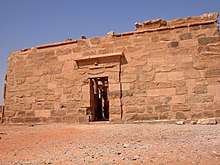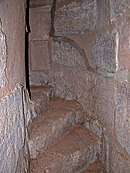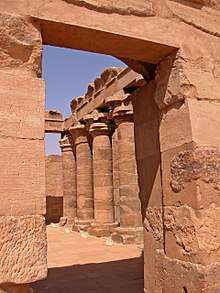Temple of Maharraqa
Al-Maharraqa (Arabic: المحرقة, DMG: Al-Maḥarraqa, Greek: Hierasykaminos) is a place in Lower Nubia, which was approximately 140 km (87 mi) south of Aswan on the southern border of the Roman empire.[1] Only a few years after the Roman conquest of Egypt in 30 BC, the Kushites from the kingdom of Meroë launched a raid on the First Cataract region of Egypt in 23 BC.[2] The Roman prefect of Egypt, Petronius, retaliated and defeated the invading Meroitic army. He then proceeded to station a Roman garrison of 400 troops at the southern outpost of Qasr Ibrim.[3] After some negotiations, a permanent frontier between Meroë and Roman Egypt was established at Maharraqa.[4] Thus, Maharraqa formed the extreme southern frontier of Roman Egypt.

The Serapis Isis Temple of Maharraqa


The Temple of Maharraqa was originally situated here before it was subsequently relocated in the mid-1960s due to the Aswan Dam project. It was dedicated to the ancient Egyptian gods Isis and Serapis.[5] This Roman-built Egyptian temple cannot be securely attributed to any Roman emperor's reign since it was never fully completed nor inscribed.[6] However, since it is known that temple building declined in Nubia after the rule of Augustus, the temple of Maharraqa might be datable to his reign.[7] The only part of the structure that was finished "was a court measuring 13.56 X 15.69 m, which was surrounded on three sides by columns."[8] The actual temple premises containing the sanctuary was never actually built. The temple, as well, lacks a formal pylon.
The Temple of Maharraqa features an architectural curiosity with a winding spiral staircase at a corner of the court, which led to its roof.[9] This is the only Egyptian temple in Nubia with a spiral staircase.
Relocation of the Temple
Since its former location was threatened by flooding from the Nile due to the construction of the Aswan dam, this small temple was dismantled in 1961 by the Egyptian Antiquities Service.[10] It was subsequently rebuilt along with the Temple of Dakka in 1966 at the New Wadi es-Sebua site which lies only 4 km (2.5 mi) west of the original Wadi es-Sebua location.[11] As Christine Hobson notes:
"A little to the north of Amada now stand the temples of Wadi es Sebua (built by Ramesses II), Dakka and Maharraka."[12]
References
- Dieter Arnold, Nigel Strudwick, Sabine Gardiner, The Encyclopaedia of Ancient Egyptian Architecture, I.B. Tauris Publishers, 2003. p.85
- Stephen Quirke & Jeffrey Spenser (ed.) The British Museum Book of Ancient Egypt, Thames & Hudson 1994. p.212
- Quirke & Spenser, p.212
- Quirke & Spenser, p.212
- Dieter Arnold, Temples of the Last Pharaohs, Oxford University Press, 1999. p.244
- Arnold, Temples of the Last Pharaohs, p.244
- Arnold, Temples of the Last Pharaohs, p.244
- Arnold, Strudwick, Gardiner, p.85
- Arnold, Strudwick, Gardiner, p.85
- Arnold, Strudwick, Gardiner, p.86
- John Baines & Jaromír Málek, Atlas of Ancient Egypt, Facts on File Publications New York, 1982. p.183
- Christine Hobson, Exploring the World of the Pharaohs: A complete guide to Ancient Egypt, Thames & Hudson 1993 paperback, p.177